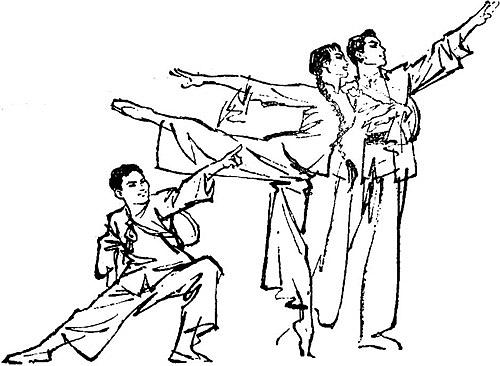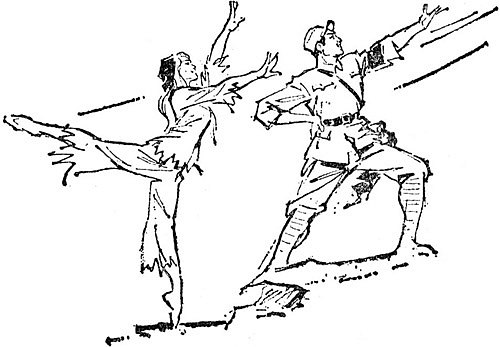|
 |
|
Hong Changqing (right), Party representative of the women's detachment, shows Wu Qionghua the way to join the revolution, from The Red Detachment of Women |
The scene from The Red Detachment of Women describes the unexpected meeting of Wu Qionghua, a poor peasant's daughter, and Hong Changqing, Party representative of the women's detachment, after the former's escape from the landlord's manor, and how he shows her the way to the liberated area. Apart from critically assimilating and transforming ballet techniques, the dancers incorporate into their movements those of Chinese dancing to bring out the heroine's rebellious character and the Party representative's image. Many of the graceful movements in these newly adapted dances are extremely difficult.
 |
|
A scene from The White-Haired Girl |
"The Sun Rises" from The White-Haired Girl, a story about the peasants' struggle against landlords during the War of Resistance Against Japan (1937-45), is a scene in the latter half of this modern revolutionary dance-drama. Xi Er, a poor peasant's daughter forced to hide in the mountains and whose hair had turned white, is found by her fellow villager Da Chun, now a PLA fighter, and his comrades-in-arms. The scene ends with their coming out of a cave under a brilliant sun.
For theatre-goers, seeing in less than three hours these selections with so many typical artistic images and excellent scenes is far more than enjoying a performance; it is a profound education for them as well. The revolutionary spirit of the heroes and heroines inspires the people to strive to defend the fruits of the revolution and win still greater victories.
The selected scenes give a many-sided expression to the artistic characteristics of the Peking opera and dance-drama. Some reveal a high degree of artistry. Presentation of them is conducive to raising the level of the actors and actresses and helps give more dimension to their specialities and styles.
In addition, presenting these selected scenes also helps push mass creative activities ahead. Inspired by their rehearsal of extracts from The Red Detachment of Women, women workers at the Peking Vinylon Mill created the Textile Workers' Dance, using ballet movements to show their activities in the socialist emulation campaign and their labour enthusiasm.
Sketches in this article are drawn by Chen Yu-hsien | 